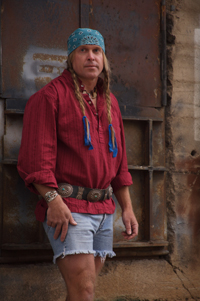Blogger Stephen Bridenstine is a fan of wilderness survival reality shows. He describes several of them:
Cody Lundin and Surviving like an IndianFirst there was Les Stroud, Canadian survival expert and filmmaker whose perilous solo journeys into the wild recesses of the world captivated audiences in the hit show Survivorman. Then came British special forces vet and high-flying stuntman Bear Grylls who impressed us with his own entertaining brand of survival on Man vs. Wild. Since these humble beginnings, a whole slew of wilderness survival imitators have sprouted up across the cable television landscape.
The newest entry in this wilderness survival genre is Dual Survivor. This Discovery Channel show features two wilderness survival instructors, primitive skills expert Cody Lundin and army trained hunter and scout Dave Canterbury.These shows sometimes have a Native flavor. Here is Lundin's role in
Dual Survivor:
Cory Lundin is the New Age hippie who combines Native inspired primitive living skills, new age spiritualism, and a sprinkling of solid science to live in harmony with the natural world.Back to schoolBridenstine grew curious about Native-inspired survivalism and Googled the subject. He found several schools that teach a Native brand of survivalism. For instance:
Boulder Outdoor Survival School
http://www.boss-inc.com/
BOSS instructors bring to their courses a diverse background of personal experiences with traditional culture. ... BOSS staff have lived and learned from the Native peoples, not to mention the knowledge gained from North America's heritage of native tribes and nations.Finally, he offers his thoughts on these schools:
The problem is that it is impossible to accurately know the motivations of each person in creating their philosophy, programs, and website. Do individuals like Cory Lundin or the Woodsmoke school have a true affinity for indigenous cultures and survival techniques or are they just sucked into the cult of the Natural-Primitive Indian? Are they simply using these images and terms to tap into our own cultural feelings toward the Natural-Primitive Indian?
In other words, are the Native images and philosophy just suggestive marketing to get an already sympathetic and interested crowd (outdoor enthusiasts, survivalists, New Age types) one step closer to playing Indian and fulfilling their ultimate fantasy?And:
Some seem to have an honest affinity for real Native skills and culture and respectfully incorporate that into their programs. Others show a love and appreciation for an idealized primitive Native lifestyle that is based more on New Age escapism and traditional stereotypes that make for powerful marketing.
And some are in between.
This whole trend is nothing new and extends all the way back to the preeminent outdoors group, the Boy Scouts who have appropriated Native imagery and philosophy for well over a century.Comment: As Bridenstine notes, these schools associate Indians with a primitive lifestyle. With tasks such as grubbing for roots and berries or rubbing two sticks to start a fire.
We frequently imagine Indians having the same skills as a wolf or bear. I.e., the ability to survive in the wilderness. I don't know exactly what these schools teach, but I'm guessing it's stereotypical. Here's why:
These schools probably don't mention that Indians built towns, pyramids, temples, multistory homes, irrigation systems, and so forth. That some Indians did complex tasks such as breeding crops, calculating planetary motions, negotiating peace treaties, and performing brain surgery. Focusing on survival skills reinforces the notion that Indians were "primitive" and couldn't do anything but survive.
Many Indians lived in societies with well-defined roles: chief, medicine man, clan leader, warrior, farmer, artisan, trader, etc. If you were an important person, maybe someone did the food gathering and preparation for you. Maybe the women did it.
Did every priest, totem-pole carver, copper miner, horse wrangler, and fisherman have the same ability to survive? I doubt it. It's stereotypical to think every Indian man, woman, and child crept through the woods doing his or her own hunting and gathering. Perhaps Montezuma, Powhatan, Sequoyah, and Wovoka could pass the survival course, but I wouldn't bet my life on it.
Indians lived in a wide range of environments. Could someone living in the Everglades survive in the Pacific Northwest? Could someone living in dense northeastern woodlands survive in an arid southwestern desert? Could someone living on the Great Plains survive in the icebound Arctic north? I doubt it.
I'm guessing a school such as the one above teaches general "woodcraft" techniques that might keep you alive in Colorado. I suspect these techniques won't keep you alive in a Gulf bayou, Amazon jungle, Alaskan tundra, or Andean mountain range. Knowing which animals to hunt and plants to gather won't help if those species don't live within reach.
In fact, we know what happened when we relocated Indians to strange environments. They often suffered and died. They didn't have some mystical connection to Mother Nature that worked no matter where they were.
Again, there are huge differences between Indian cultures, so teaching one set of skills is false or misleading. It implies that all Indians fit our stereotypical notion of how Indians lived: a primitive, nomadic existence in a forest somewhere. Some Indians lived that way, but many didn't.
For more on the subject, see Review of Fierce People and Uncivilized Indians.
Below: Cory Lundin as a pseudo-Apache survivalist.



No comments:
Post a Comment